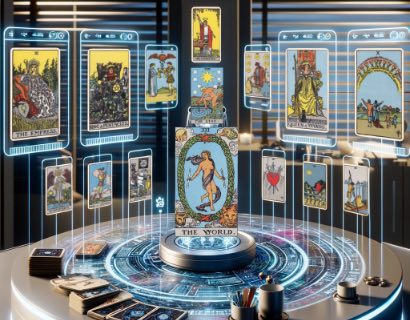The High Priestess Tarot Card Meaning & Interpretations

The High Priestess was traditionally named La Papessa (the Popess) and was based on the legend of a female pope called Pope Joan from the middle ages, a great secret that the Roman Church reputedly covered up. The basic meaning of The High Priestess is secrecy, hidden truth, facts and knowledge. It alludes to esotericism, a word which comes from the Greek esôterikós meaning "belonging to an inner circle". It is the practice of keeping knowledge away from the masses and only teaching it to an elite few. Tarot itself was originally a form of esoteric teachings transmitted by images that could only be interpreted with the help of an initiator, which the The High Priestess represents. The word Arcana comes from the Latin arcanus meaning "hidden" or "secret". Tarot's creation occurred during a time when the church would have severely punished anyone who taught anything other than Christian doctrine. The official purpose of Tarot would have been that it was nothing more than a card game but why go to such lengths as including a Major Suit with such deeply symbolic characters? Not until the 18th century is there any documented proof that it was used for cartomancy and divination but by then the church's power to persecute had diminished.
The numerology of The High Priestess is just as subtle as the card itself. The number 2 is, like the number 1, an easy number to grasp the symbology of with its themes of balance, fairness, tactfulness and cooperation which are easily recognised in the other cards such as Justice. The High Priestess connection to the symbology of 2 isn't so immediately obvious. The Minor Arcana cards numbered 2 are all directly linked to the The High Priestess and she represents their combined symbology on a higher plane. Each minor 2 symbolises the need for balance and diplomacy within its element. These minor cards are the negotiators for their elements. Anyone skilled at negotiation will understand the need for secrecy because knowledge of your opponents position can provide sufficient power to tip the negotiations in your favour. Like a game of cards you need to keep them covered and not give away any hint of what you really have to offer. By creating the false impression of having a better hand than you have you can negotiate from a stronger position. The High Priestess, being the keeper of secrets and mysteries, is the ultimate negotiator in the deck and in dealing with her you must be careful with revealing too much of yourself or believing anything she is showing or telling you.
The Rider Waite Smith (RWS) deck changed the name of the card from La Papessa to the The High Priestess. In addition to this the purely christian theme was changed to include Kabbalahistic symbology with the inclusion of the two pillars labelled B and J and the book held by the Priestess having the word Tora added. The letters on the pillars are a reference to Boaz and Jachin which were two pillars that stood at the entrance to Solomon's Temple and are also Freemasonry symbols. The word Tora is actually Torah but the artists, Pamela C. Smith, has obscured from view the final letter of the 5 as another symbolic gesture referencing this cards central theme of secrecy. The word Torah means "Instruction", "Teaching" or "Law". At the feet of the Priestess is a crescent moon linking this card to The Moon. It is a thin crescent moon because this symbolises faint light which, in the darkness of night, reveals very little to the eyes. Behind the Priestess is a curtain, or Parochet, with pomegranates arranged in a Tree of Life pattern. Her head is in the Tree of Life position of Da’at which represents Knowledge.
The High Priestess is a card of secrecy, hidden facts, privacy and forbidden knowledge. She is a teacher of specialised knowledge. An initiator into private clubs and inner circles. She is a master negotiator and card player who will purposely obscure her position to gain the upper hand. The High Priestess also relates to Divine Law and Gnosis. That is spiritual, or religious, knowledge. For this reason the card can sometimes point to a person who practices the divinatory arts, such as a Tarot Reader, Psychic, Astrologer, Numerologist etc. In drawing this card in the position of a solution, its message maybe to trust your inner voice, to use your intuition, rather than what you are being shown. Or that there is knowledge you must seek out and perhaps someone who has it who you can turn to for help.
© Phuture Me Ltd 2010-2019. All rights reserved.
THE PICTORIAL KEY TO THE TAROT
By Arthur Edward Waite (1911)
She has the lunar crescent at her feet, a horned diadem on her head, with a globe in the middle place, and a large solar cross on her breast. The scroll in her hands is inscribed with the word Tora, signifying the Greater Law, the Secret Law and the second sense of the Word. It is partly covered by her mantle, to shew that some things are implied and some spoken. She is seated between the white and black pillars--J. and B.--of the mystic Temple, and the veil of the Temple is behind her: it is embroidered with palms and pomegranates. The vestments are flowing and gauzy, and the mantle suggests light--a shimmering radiance. She has been called occult Science on the threshold of the Sanctuary of Isis, but she is really the Secret Church, the House which is of God and man. She represents also the Second Marriage of the Prince who is no longer of this world; she is the spiritual Bride and Mother, the daughter of the stars and the Higher Garden of Eden. She is, in fine, the Queen of the borrowed light, but this is the light of all. She is the Moon nourished by the milk of the Supernal Mother.
In a manner, she is also the Supernal Mother herself--that is to say, she is the bright reflection. It is in this sense of reflection that her truest and highest name in bolism is Shekinah--the co-habiting glory. According to Kabalism, there is a Shekinah both above and below. In the superior world it is called Binah, the Supernal Understanding which reflects to the emanations that are beneath. In the lower world it is MaIkuth--that world being, for this purpose, understood as a blessed Kingdom that with which it is made blessed being the Indwelling Glory. Mystically speaking, the Shekinah is the Spiritual Bride of the just man, and when he reads the Law she gives the Divine meaning. There are some respects in which this card is the highest and holiest of the Greater Arcana.
Related Tarot Cards
 |
 |
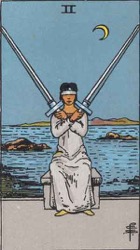 |
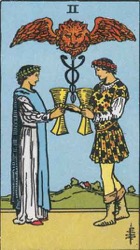 |
 |
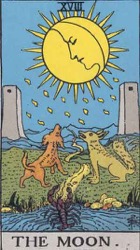 |
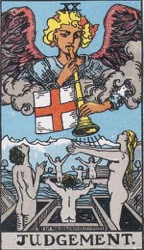 |
© Phuture Me Ltd 2019. All rights reserved.
